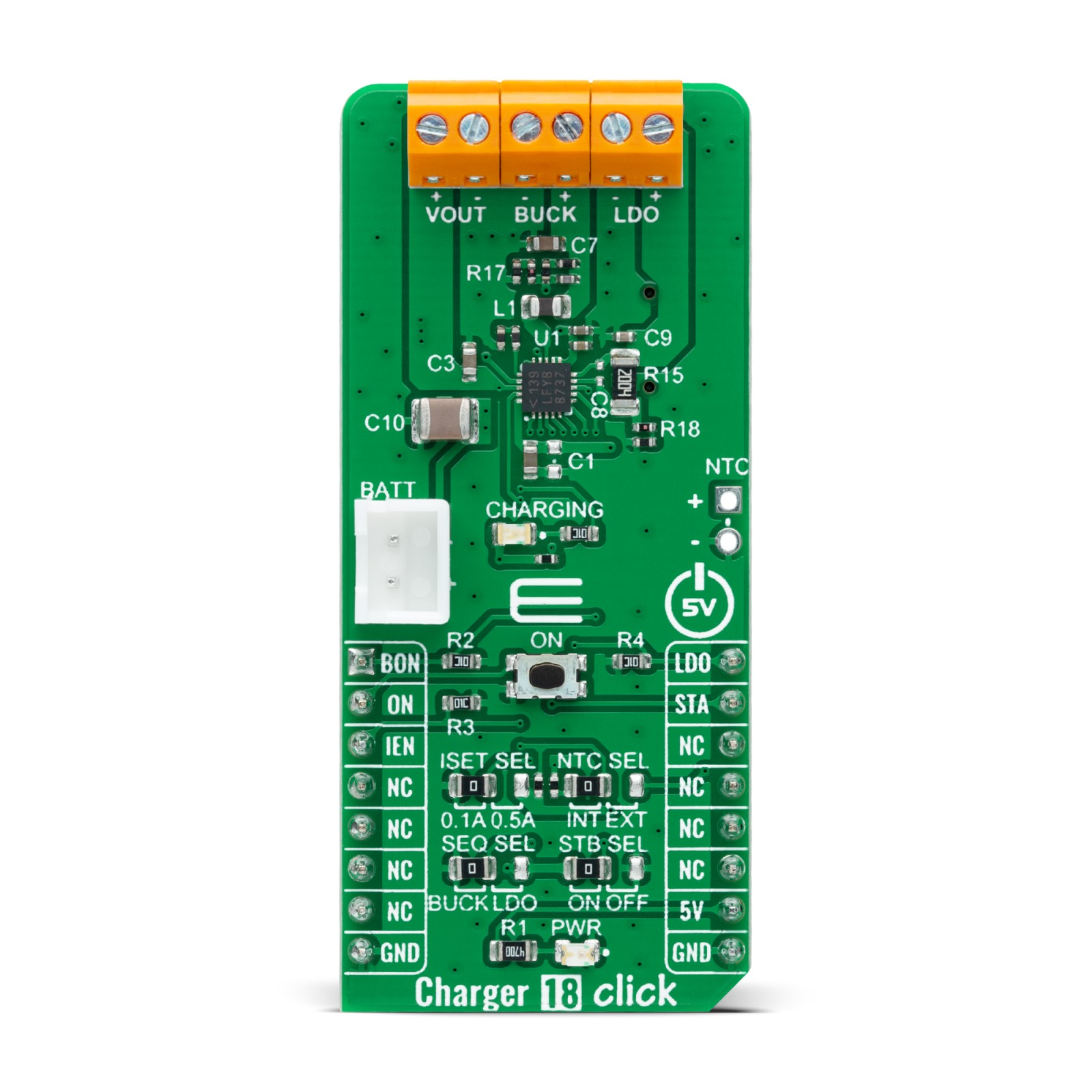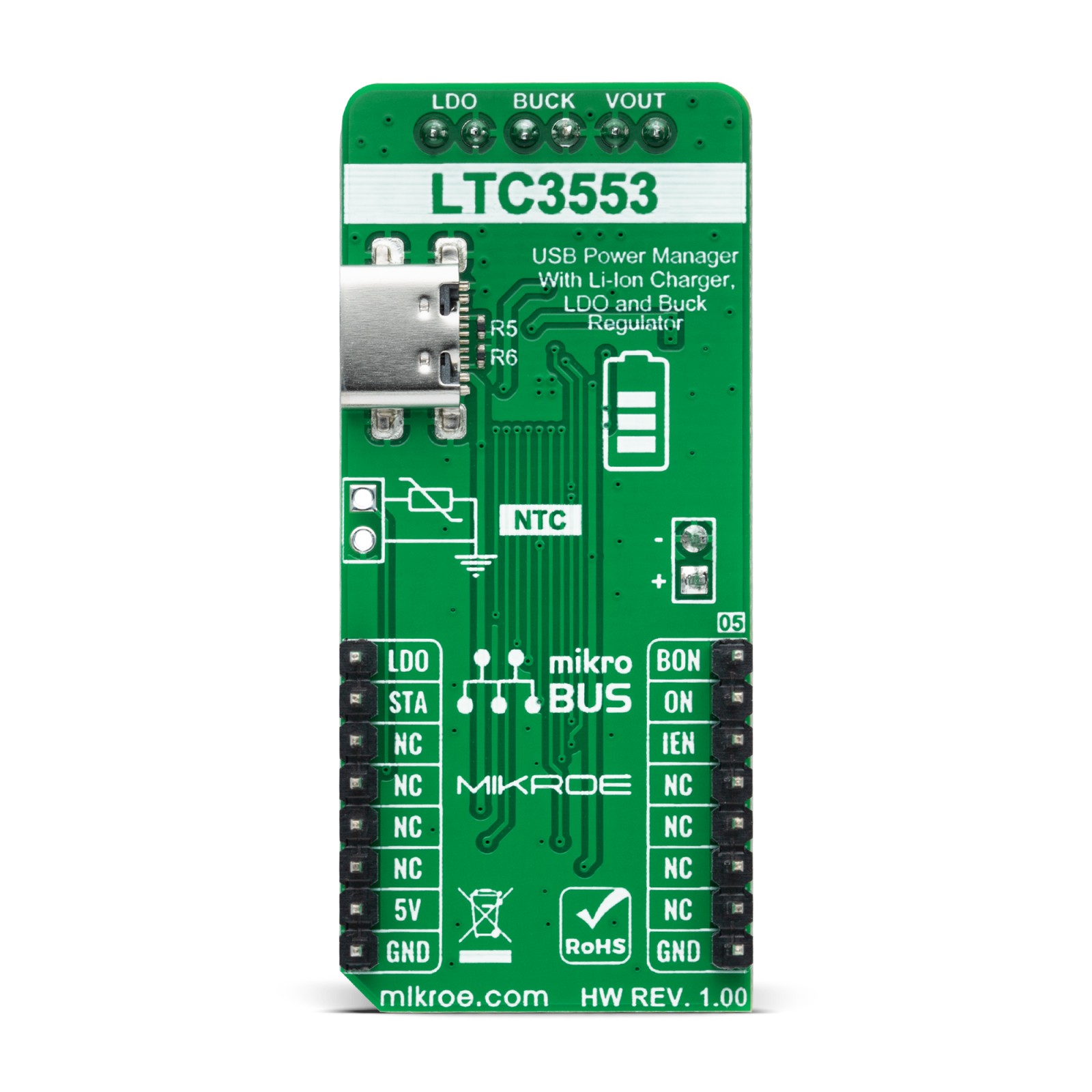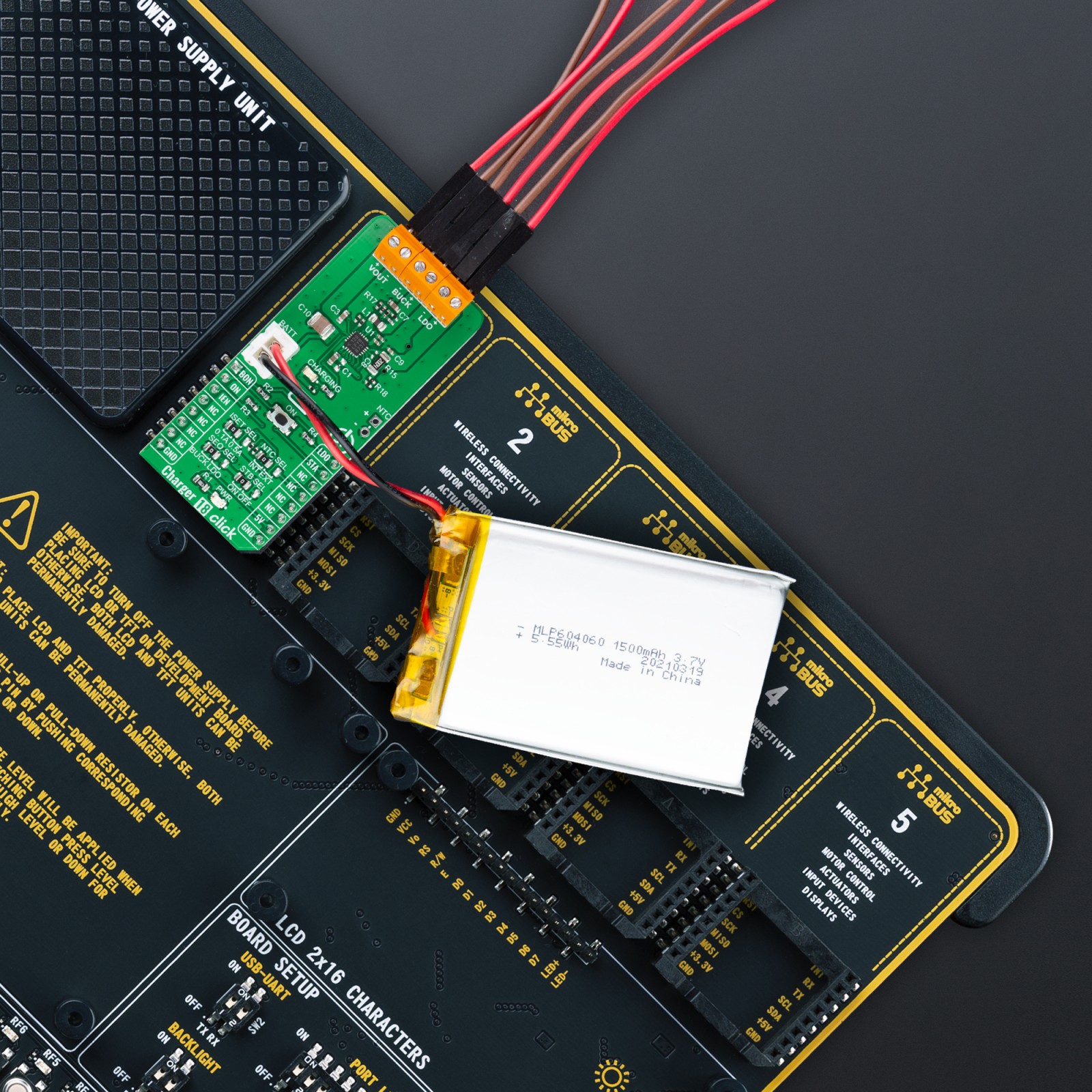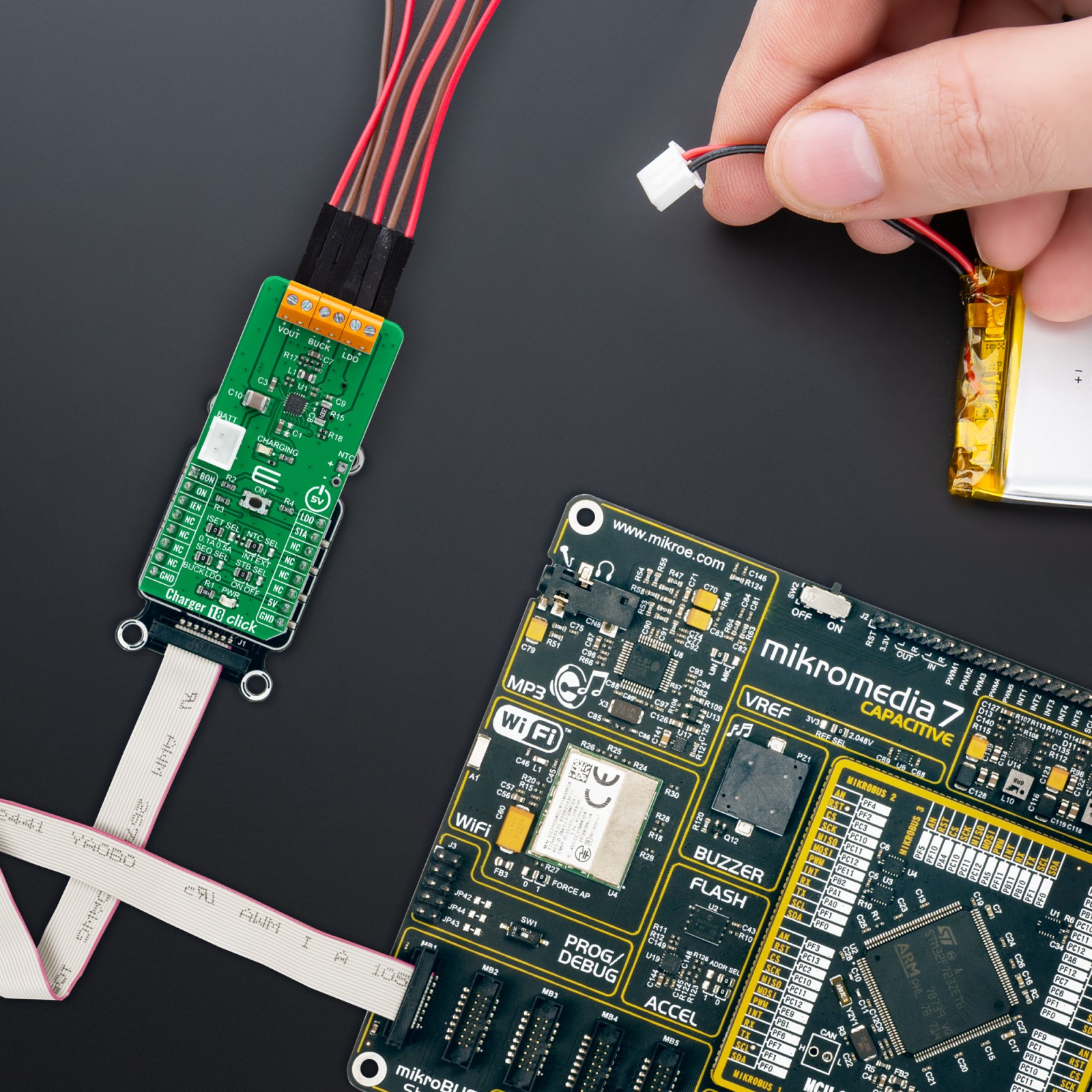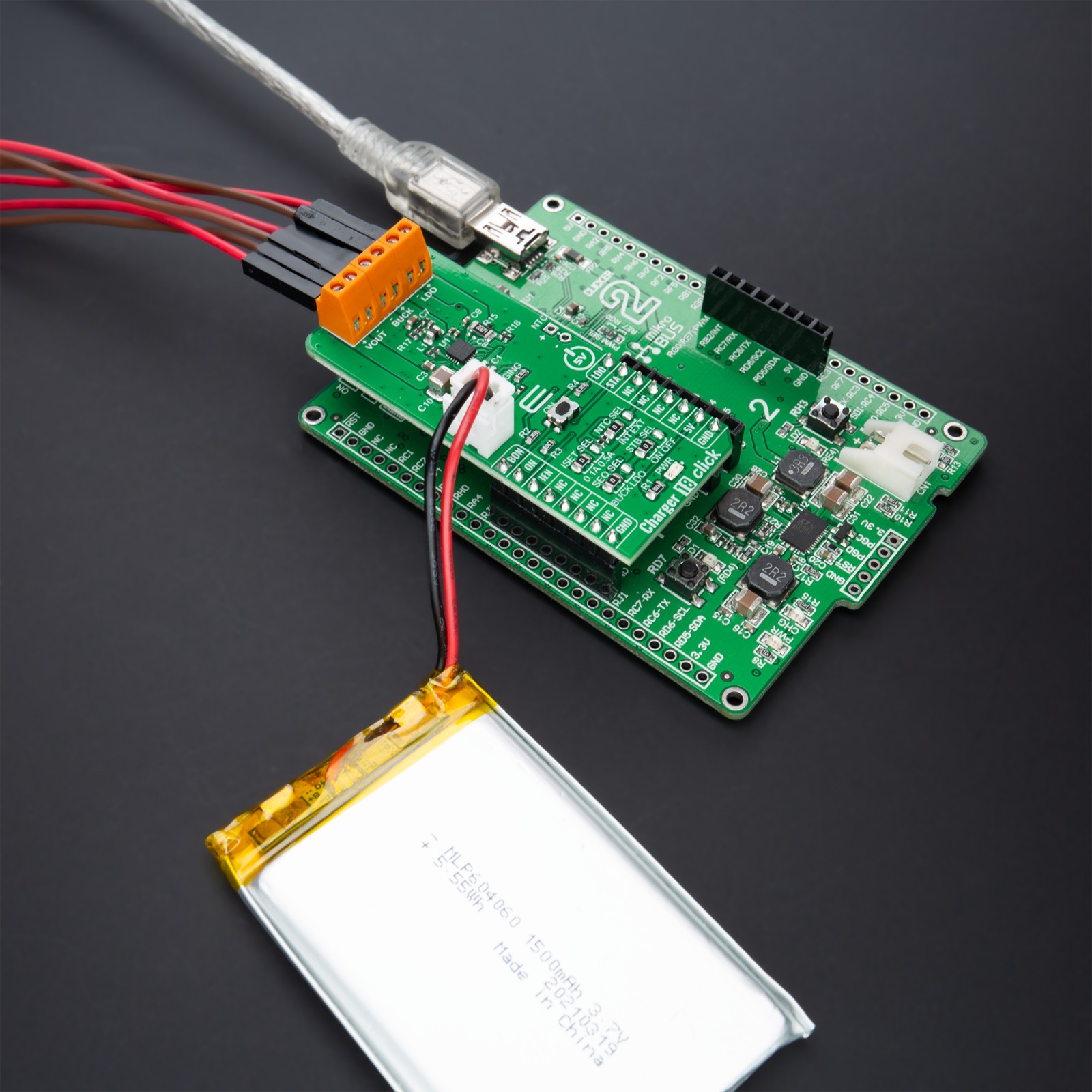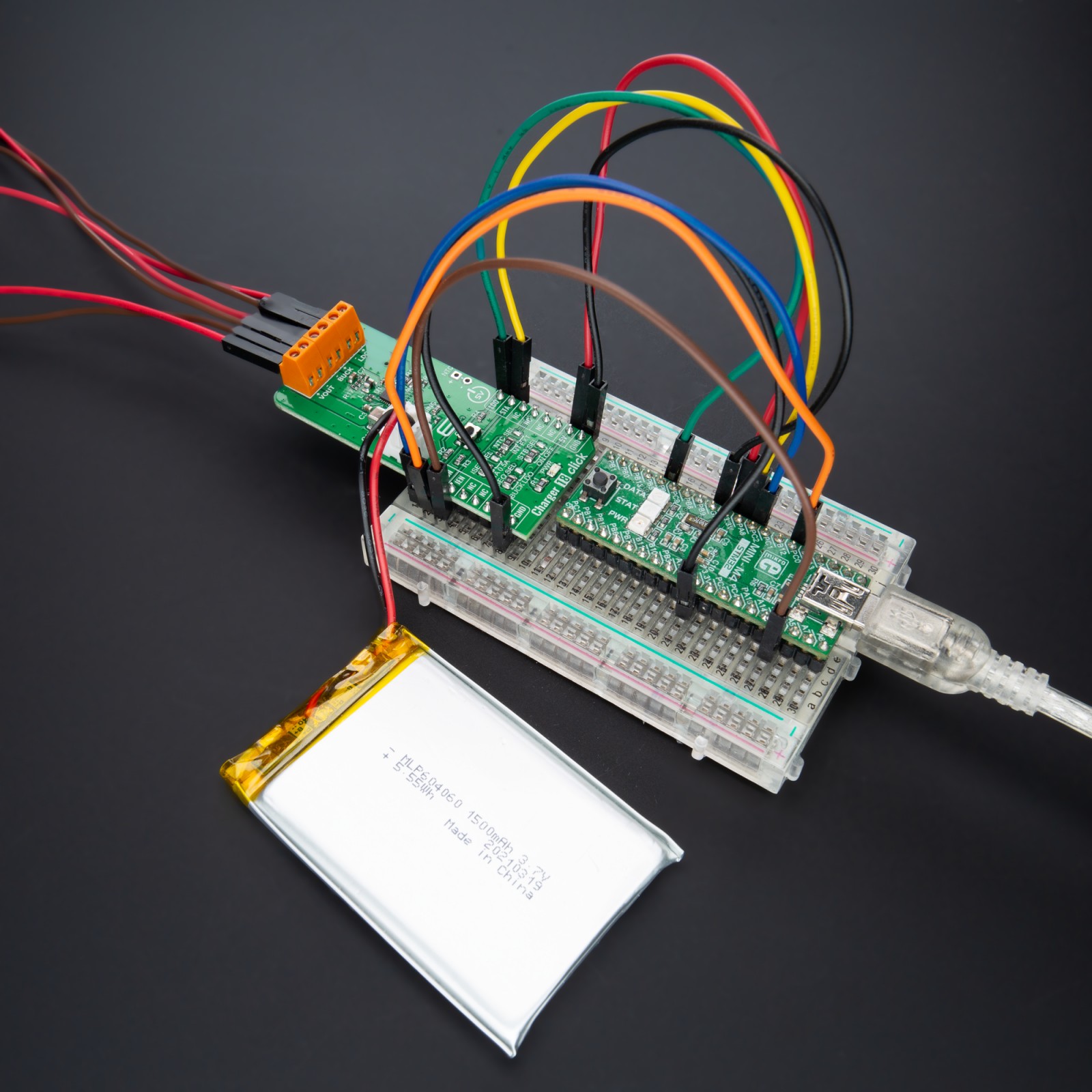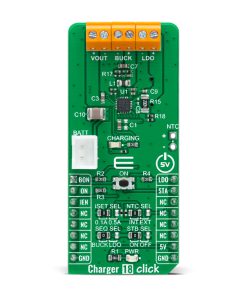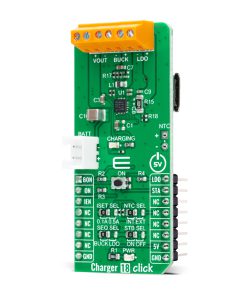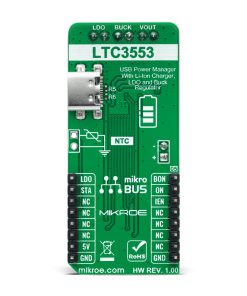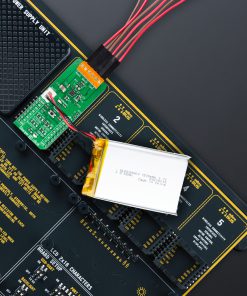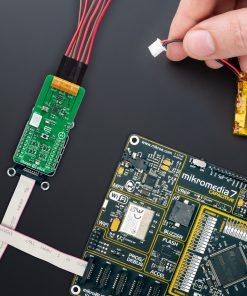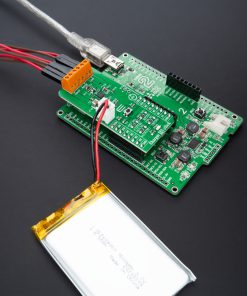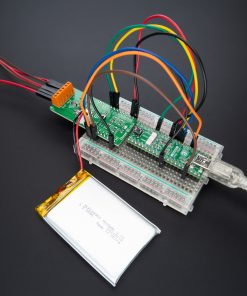Charger 18 Click
R635.00 ex. VAT
Charger 18 Click is a compact add-on board representing a single-cell battery charger. This board features the LTC3553, a micropower, highly integrated power management, and battery charger for single-cell Li-Ion/Polymer battery applications from Analog Devices. Designed specifically for USB applications, it also includes a PowerPath manager with automatic load prioritization and input current limit, a battery charger, and numerous internal protection features. It also indicates a battery charge state, and it comes with a synchronous 200mA buck regulator and a 150mA low dropout linear regulator (LDO). This Click board™ is suitable as a Li-Ion/Polymer battery charger for portable devices and accessories, power tools, and more.
Charger 18 Click is supported by a mikroSDK compliant library, which includes functions that simplify software development. This Click board™ comes as a fully tested product, ready to be used on a system equipped with the mikroBUS™ socket.
Stock: Lead-time applicable.
| 5+ | R603.25 |
| 10+ | R571.50 |
| 15+ | R539.75 |
| 20+ | R519.43 |
How does it work?
Charger 18 Click as its foundation uses the LTC3553, a micropower multifunction power management integrated circuit (PMIC) for portable Li-Ion/Polymer battery-based applications from Analog Devices. It combines a USB-compatible PowerPath manager with automatic load prioritization delivering up to 400mA battery charge current from a 5V USB input. The device’s ‘instant-on’ operation ensures immediate system load power when a USB supply is available, even with a fully discharged battery. Alongside a stand-alone battery charger, it also has a high-efficiency synchronous 200mA buck regulator and a 150mA low dropout linear regulator available on the present onboard connectors.

This Click board™ has an input current limit selection allowing the user to select between 100mA and 500mA input current limit. The choice can be made by positioning the SMD jumper labeled as ISET SEL to an appropriate position. Besides ISET, it also possesses SEQ SEL jumper selection determining which regulator is enabled before the other. The first-regulator power-up selection is made by positioning this SMD jumper to an appropriate position marked as BUCK or LDO.
On the other hand, the BON and LDO pins routed to the AN and PWM pins on the mikroBUS™ socket enable the buck and LDO regulators by setting these pins to a high logic state. Alongside these pins, the LTC3553 also includes a pushbutton input to control the two regulators and system reset – an onboard pushbutton labeled ON, also routed to the RST pin on the mikroBUS™, representing the Regulator Ignition button. Pressing the button causes an STA interrupt, informing the MCU that this event has occurred.
These regulators are also related to a Standby Mode, selectable through an SMD jumper labeled as ISET SEL. When this jumper is placed ON, the buck and the LDO regulator quiescent current are reduced to low levels while maintaining output voltage regulation. The buck regulator is limited to a 10mA maximum load current in this mode, and the LDO regulator’s response to line and load transients is slower.
As already mentioned in the text, this Click board™ communicates with MCU using several GPIO pins. With the IEN pin routed to the CS pin on the mikroBUS™ socket is pulled high, the LTC3553 enters Suspend mode to comply with the USB specification. In this mode, the power path between USB and VOUT is put in a high impedance state to reduce the USB input current. This Click board™ also comes with a blue LED labeled as CHARGING for battery charging state.
An NTC function is also available for temperature-qualified charging. The temperature monitoring feature is selectable via jumper labeled as NTC SEL, where the user can choose between external or internal modes of monitoring. A negative temperature coefficient (NTC) thermistor input for the battery temperature monitor is provided for external mode.
This Click board™ can be operated only with a 5V logic voltage level. The board must perform appropriate logic voltage level conversion before using MCUs with different logic levels. However, the Click board™ comes equipped with a library containing functions and an example code that can be used, as a reference, for further development.
Specifications
Type
Battery charger
Applications
Can be used as a Li-Ion/Polymer battery charger for portable devices and accessories, power tools, and more
On-board modules
LTC3553 – micropower, highly integrated power management, and battery charger for single-cell Li-Ion/Polymer battery applications from Analog Devices
Key Features
High efficiency, USB, integrated buck and LDO regulators, accuracy, programmable input current limit, battery charging indication, and more
Interface
GPIO
Feature
No ClickID
Compatibility
mikroBUS™
Click board size
L (57.15 x 25.4 mm)
Input Voltage
5V,External
Pinout diagram
This table shows how the pinout on Charger 18 Click corresponds to the pinout on the mikroBUS™ socket (the latter shown in the two middle columns).
Onboard settings and indicators
| Label | Name | Default | Description |
|---|---|---|---|
| LD1 | PWR | – | Power LED Indicator |
| LD2 | CHARGING | – | Charge Status LED Indicator |
| JP1 | ISET SEL | Left | Current Limit Selection 0.1A/0.5A: Left position 0.1A, Right position 0.5A |
| JP2 | SEQ SEL | Left | Regulator Power-Up Sequence Selection BUCK/LDO: Left position BUCK, Right position LDO |
| JP3 | STB SEL | Left | Standby Mode Selection ON/OFF: Left position ON, Right position OFF |
| JP4 | NTC SEL | Left | Battery Pack Thermistor Selection INT/EXT: Left position INT, Right position EXT |
| T1 | ON | – | Regulator Ignition Button |
| J1 | NTC | Unpopulated | External Thermistor Connection Header |
Charger 18 Click electrical specifications
| Description | Min | Typ | Max | Unit |
|---|---|---|---|---|
| Supply Voltage | – | 5 | – | V |
| Charge Output Current | – | 400 | – | mA |
| Buck Regulator Output Current | – | 200 | – | mA |
| LDO Output Current | – | 150 | – | mA |
| Operating Temperature Range | -40 | +25 | +85 | °C |
Software Support
We provide a library for the Charger 18 Click as well as a demo application (example), developed using MikroElektronika compilers. The demo can run on all the main MikroElektronika development boards.
Package can be downloaded/installed directly from NECTO Studio Package Manager(recommended way), downloaded from our LibStock™ or found on Mikroe github account.
Library Description
This library contains API for Charger 18 Click driver.
Key functions
-
charger18_buck_controlThis function controls the buck regulator enable state of Charger 18 click board. -
charger18_ldo_controlThis function controls the low dropout (LDO) regulator enable state of Charger 18 click board. -
charger18_suspend_controlThis function controls the suspend charging mode state of Charger 18 click board.
Example Description
This example demonstrates the use of Charger 18 Click board™ by controlling the status of the charger as well as the LDO and BUCK regulators.
void application_task ( void )
{
charger18_suspend_control( &charger18, CHARGER18_CONTROL_DISABLE );
log_printf( &logger, " CHARGER : ONrn" );
Delay_ms( 10000 );
charger18_suspend_control( &charger18, CHARGER18_CONTROL_ENABLE );
log_printf( &logger, " CHARGER : OFFrn" );
Delay_ms( 3000 );
charger18_buck_control( &charger18, CHARGER18_CONTROL_ENABLE );
log_printf( &logger, " BUCK : ONrn" );
Delay_ms( 3000 );
charger18_buck_control( &charger18, CHARGER18_CONTROL_DISABLE );
log_printf( &logger, " BUCK : OFFrn" );
Delay_ms( 3000 );
charger18_ldo_control( &charger18, CHARGER18_CONTROL_ENABLE );
log_printf( &logger, " LDO : ONrn" );
Delay_ms( 3000 );
charger18_ldo_control( &charger18, CHARGER18_CONTROL_DISABLE );
log_printf( &logger, " LDO : OFFrnn" );
Delay_ms( 3000 );
}
The full application code, and ready to use projects can be installed directly from NECTO Studio Package Manager(recommended way), downloaded from our LibStock™ or found on Mikroe github account.
Other Mikroe Libraries used in the example:
- MikroSDK.Board
- MikroSDK.Log
- Click.Charger18
Additional notes and informations
Depending on the development board you are using, you may need USB UART click, USB UART 2 Click or RS232 Click to connect to your PC, for development systems with no UART to USB interface available on the board. UART terminal is available in all MikroElektronika compilers.
mikroSDK
This Click board™ is supported with mikroSDK – MikroElektronika Software Development Kit. To ensure proper operation of mikroSDK compliant Click board™ demo applications, mikroSDK should be downloaded from the LibStock and installed for the compiler you are using.
For more information about mikroSDK, visit the official page.
Resources
Downloads
| Weight | 22 g |
|---|---|
| Brand | MikroElektronika |

